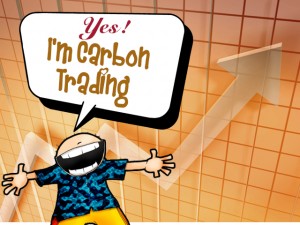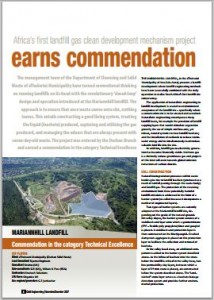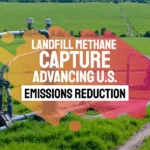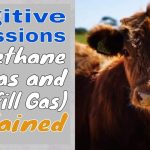Frequently Asked Questions in Carbon Trading
How does the EU Emissions Trading Scheme (the “EU ETS” – also referred to as CCTS, and CDM) affect the Waste Industry?
 First of all – both hazardous and municipal waste incinerators will not be subject to the scheme.
First of all – both hazardous and municipal waste incinerators will not be subject to the scheme.
However, the burning of landfill gas (either on its own or mixed with other fuel) is included in the scheme. (The scheme actually specifies that to fall within the scheme the gas must be burnt either on its own or mixed with other fuel, in a combustion installation with a rated thermal input of 20MW or greater.)
I am operating a flare which is burning landfill gas with a rated thermal input of more than 20MW. Does this mean for me?
It has been illegal in the UK to operate any flare without a “Greenhouse Gas Permit” (“permit”), since 1 January 2005.
How did this come about?
On 13 October 2003, the European Parliament and Council adopted a new Directive to establish a method for the trading of greenhouse gas emissions (the “EU ETS). On 31 December 2003, the UK Government passed regulations implementing the EU ETS, (known as The Greenhouse Gas Emissions Trading Scheme Regulations 2003).
When did the first EU Emissions Trading Scheme start?
The EU ETS started on 1 January 2005 throughout the EU.
What is the purpose of Emissions Trading?

The overriding purpose is to facilitate businesses which fall within the scheme to comply with the emissions targets which will be set by the EU governments, with the ultimate goal of the EU achieving compliance with the promised reductions in Carbon Dioxide emissions in order to limit the effects of global warming.
On what basis will a “Green House Gas Permit” be issued?
On 19 January 2004 the UK Government issued a draft National Allocation Plan (“draft NAP”), and at the same time a consultation paper explaining the proposals. In the draft NAP provisional figures have been listed for the Phase 1 of the EU ETS (2005 to 2007), with an explanation of how these will be allocated to the existing installations, but for 5.7% which will be held for new entrants in a reserve fund.
The allocation of allowances to individual installations is calculated according to each installation's average share of annual emissions between 1998 and 2002, excluding the lowest year's emissions. If only one year's data is available this data will be used.
Those in the power generation business (including energy from landfill gas) will be required to take most of the responsibility for carbon dioxide reduction.
How do you obtain a permit?
Apply to the EA. (NB: Most operators will be familiar with this having already filled in a NAP data form, as requested by the EA/DEFRA.)
Contact us here if you seek assistance from our landfill gas team in applying for an EU ETS permit.
Carbon Credits Update (November 2012)
The December 2011 United Nations Framework Convention on Climate Change (UNFCCC) 17th Conference of the Parties in Durban, South Africa, was a success for the European Union (EU). The emission targets of the first Kyoto Protocol commitment period were poised to expire in 2012, unless a new agreement could be reached. That meant that the negotiations in Durban were the last chance to secure their continuation and avoid a hiatus in commitments.
The EU only agreed to participate in a second commitment period on the basis that the negotiations would result in a roadmap for a legally binding post-2020 agreement. Such an agreement would include mitigation commitments for all major economies. So, the parties worked out a compromise that extended the Kyoto Protocol beyond 2012 and called for negotiations towards “a protocol, another legal instrument or an agreed outcome with legal force … [and] applicable to all Parties”.
So, the current position is that the Durban agreement gaves the international community until 2015 to conclude negotiations on the post-2020 climate change regime, and meanwhile the EU ETS continues and carbon credits are traded as normal.
However, the language in the text has been left intentionally imprecise to keep the door open for several possible future developments.
The 18th Conference of the Parties in Doha, Qatar, which (at the time of writing this) has only just finished (26 November to 7 December 2012), has been the first occasion for the delegations to in negotiate towards a compromise to allow the Carbon Credits EU ETS scheme to continue and it must now be agreed by 2015, to avoid the scheme lapsing.
The EU has, and no doubt still will, press the case hard on the need to close the ‘ambition gap' between emission-reduction commitments and the cuts the scientific community considers essential to avoid dangerous climate change. However, commentators have noted that sticking to the current emission-reduction commitment of 20% below 1990 levels could undermine the EU's credibility and leadership. That's because the collective emissions of the 27 member states of the EU (EU-27) were 17.5% below 1990 levels already in 2011, which means that it can achieve its current 20% reduction pledge without much additional abatement. It has to do better than that, but the EU will be seen as hardly making any efforts itself. The EU won't make any friends by telling other developing nations to take a bigger burden, when for them any reduction at all in their growth in carbon emissions is very hard due to their economic expansion.
Methane Emissions from Landfills: Problems and Solutions
Methane emissions from landfills significantly contribute to climate change due to their potent greenhouse effect. Capturing and utilizing landfill gas as energy, reducing organic waste, and enhancing recycling are vital solutions. Community engagement and effective policy regulations are key to mitigating these emissions and tackling global warming effectively…
Landfill Gas Capture: Advancing U.S. Emissions Reduction Through Technology and Policy
Harnessing Landfill Gas: Progress and Challenges in U.S. Emissions Reduction Efforts The management of landfill-derived gas represents one of the most significant opportunities in America's climate strategy. As a potent greenhouse gas with 28-36 times the warming potential of carbon dioxide over a 100-year period, methane demands urgent attention from policymakers, waste management professionals, and […]
Outcomes of COP26 – Pledges and What the Methane Emissions Target Means for Landfill Gas Companies
There were at least 5 important outcomes of COP26. In this article, we provide a short summary of the pledges which were agreed at the COP26 summit last November in Glasgow, in video and as text. The 26th United Nations (UN) climate change conference of the parties (COP26) took place in Glasgow in November 2021. […]
Fugitive Emissions of Methane and Landfill Gas Explained
It is well known that fugitive emissions of methane and landfill gas occur when methane escapes from production facilities, wells, pipes, compressors and other equipment associated with coal mining or natural gas extraction, landfills, and biogas plants. It is obviously very important to reduce fugitive emissions to an absolute minimum. Why are Fugitive Escapes of […]








